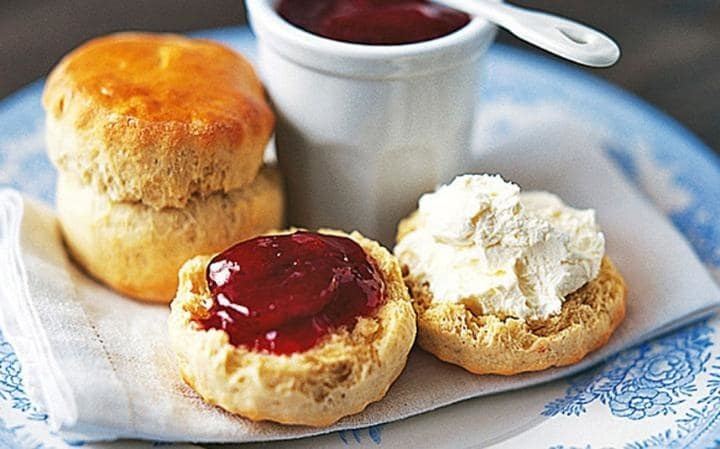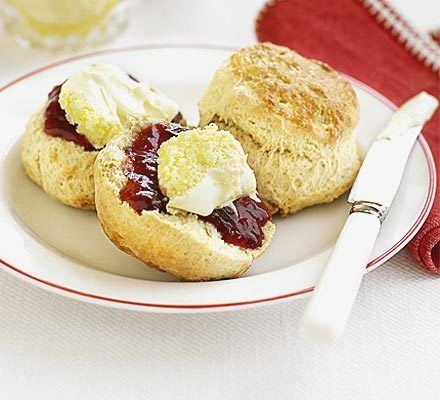Type Cake or quick bread | ||
 | ||
Similar Bread, Muffin, Sugar, Pancake, Shortbread | ||
Apple scone cake recipe demonstration joyofbaking com
A scone is a single-serving quick bread/cake, usually made of wheat, barley or oatmeal with baking powder as a leavening agent and baked on sheet pans. A scone is often lightly sweetened and occasionally glazed with egg wash. The scone is a basic component of the cream tea or Devonshire tea. It differs from teacakes and other sweet buns that are made with yeast.
Contents
- Apple scone cake recipe demonstration joyofbaking com
- How to make perfect english scones cupcake jemma
- Lexicology
- History
- Varieties
- Europe
- Australia
- Americas
- Other usage
- References

How to make perfect english scones cupcake jemma
Lexicology

The pronunciation of the word within the English-speaking world varies. According to one academic study, two-thirds of the British population pronounce it /ˈskɒn/ (rhymes with gone) with the preference rising to 99% in the Scottish population. This is also the pronunciation of Australians and Canadians. Others, including natives of Ireland and the United States, pronounce the word as /ˈskoʊn/ (rhymes with tone). British dictionaries usually show the /ˈskɒn/ form as the preferred pronunciation, while recognising the /ˈskoʊn/ form.

The Oxford Dictionaries explain that there are also regional and class differences in England connected with the different pronunciations:

There are two possible pronunciations of the word scone: the first rhymes with gone and the second rhymes with tone. In US English, the pronunciation rhyming with tone is more common. In British English, the two pronunciations traditionally have different regional and class associations, with the first pronunciation associated with the north of England, while the second is associated with the south.
The difference in pronunciation is alluded to in a poem:
The Oxford English Dictionary reports that the first mention of the word was in 1513. Origin of the word scone is obscure and may, in fact, derive from different sources. That is, the classic Scottish scone which, according to Sheila MacNiven Cameron in The Highlander's Cookbook, originated as a bannock cut into pieces; and the Dutch schoonbrood or "spoonbread" (very similar to the drop scone); and possibly other, similar and similarly named quick breads, may have made their way onto the British tea table, where their similar names merged into one.
Thus, scone may derive from the Middle Dutch schoonbrood (fine white bread), from schoon (pure, clean) and brood (bread), and/or it may also derive from the Scots Gaelic term sgonn meaning a shapeless mass or large mouthful. The Middle Low German term Schönbrot meaning fine bread may also have played a role in the origination of this word. And if the explanation put forward by Sheila MacNiven Cameron be true, the word may also be based on the town of Scone (/ˈskuːn/) (Scots: Scuin, Scottish Gaelic: Sgàin) in Scotland, the ancient capital of that country – where Scottish monarchs were still crowned, even after the capital was moved to Perth, then to Edinburgh (and on whose Scone Stone the monarchs of the United Kingdom are still crowned today).
History
The original scone was round and flat, usually as large as a medium-sized plate. It was made with unleavened oats and baked on a griddle (or girdle, in Scots), then cut into triangular sections for serving. Today, many would call the large round cake a bannock, and call the triangles scones. In Scotland, the words are often used interchangeably.
When baking powder became available to the masses, scones began to be the oven-baked, well-leavened items we know today. Modern scones are widely available in British bakeries, grocery stores, and supermarkets. A 2005 market report estimated the UK scone market to be worth £64m, showing a 9% increase over the previous five years. The increase is partly due to an increasing consumer preference for impulse and convenience foods.
Scones sold commercially are usually round, although some brands are hexagonal as this shape may be tessellated for space efficiency. When prepared at home, they may take various shapes including triangles, rounds and squares. Baking scones at home is often closely tied to heritage baking. They tend to be made using family recipes rather than recipe books, since it is often a family member who holds the "best" and most-treasured recipe.
Varieties
British scones are often lightly sweetened, but may also be savoury. They frequently include raisins, currants, cheese or dates. In Scotland and Ulster, savoury varieties of scone include soda scones, also known as soda farls, and potato scones, normally known as tattie scones, which resemble small, thin savoury pancakes made with potato flour. Potato scones are most commonly served fried in a full Scottish breakfast or an Ulster fry.
The griddle scone (or "girdle scone" in Scots) is a variety of scone which is cooked on a griddle (or girdle) on the stove top rather than baked in the oven. This usage is also common in New Zealand where scones of all varieties form an important part of traditional colonial New Zealand cuisine.
Other common varieties include the dropped scone, or drop scone, like a pancake, after the method of dropping the batter onto the griddle or frying pan to cook it, and the lemonade scone, which is made with lemonade and cream instead of butter and milk. There is also the fruit scone or fruited scone, which contains currants, sultanas, peel and glacé cherries, which is just like a plain round scone with the fruit mixed into the dough.
In some countries one may also encounter savoury varieties of scone which may contain or be topped with combinations of cheese, onion, bacon, etc.
Europe
Scones were chosen as the Republic of Ireland representative for Café Europe during the Austrian Presidency of the European Union in 2006, while the United Kingdom chose shortbread.
In Hungary, a pastry very similar to the British version exists under the name "pogácsa". The name has been adopted by several neighbouring nations' languages. (E.g. Pogatsche in German.) Pogácsa is almost always savoury and served with varied seasonings and toppings, like dill and cheese.
Australia
Pumpkin scones, made by adding mashed cooked pumpkin to the dough mixture, had increased exposure during the period when Florence Bjelke-Petersen was in the public eye. Date scones, which contain chopped dried dates, can also be found in Australia. Another old style of cooking scones, generally in the colder months, is to deep-fry or deep pan-fry them in dripping or oil, when they are called "puftaloons".
Americas
Round British scones can resemble North American biscuits in appearance, but scones traditionally rely on cold butter, while biscuits are more often made with other kinds of animal fat or vegetable shortening. Also, while scones are frequently (but not always) sweet, and served with coffee and tea, biscuits are served more as a bread, often with breakfast in the South.
In recent years, scones under that name have begun to appear in coffee houses. They may be sweet, often containing fruit such as blueberries or raspberries, or else such flavorings as cinnamon.
In Utah, the bread products locally called "scones" are similar to Native American frybread or New Orleans beignets and are made from a sweet yeast dough, with buttermilk and baking powder and/or soda added, and they are fried rather than baked. They are customarily served with butter and either honey or maple syrup.
Scones are quite popular in Argentina as well as Uruguay. They were brought there by Irish, English and Scottish immigrants and by Welsh immigrants in Patagonia (Britons are the third largest foreign community in Argentina). They are usually accompanied by tea, coffee or mate.
Other usage
In Scots the verb scon means to crush flat or beat with the open hand on a flat surface, and "scon-cap" or "scone-cap" refers to a man's broad flat cap or "bunnet".
In Australian and New Zealand English, scone is both a slang term for the head and a verb meaning to knock on the head.
